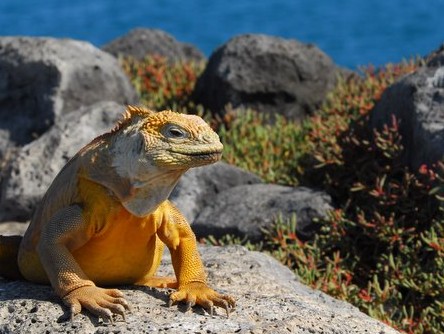
Caught stealing ! German tourist arrested for stealing rare iguanas from Galapagos Islands in Ecuador.
Galapagos Islands / NationalTurk – A German tourist has been detained by Galapagos police for allegedly trying to smuggle four endangered iguanas out of the Galapagos Islands, Galapagos National Park informed.
The Galapagos National Park rangers reported they had intercepted the runaway man on Monday at the Guayaguil International airport close to the amazing archipelago after he was seen carrying a suspicious package, which was found to contain four iguana lizards wrapped in canvas.
The smuggled reptiles appear to be Galapagos Land Iguanas (conolophus subcristatus), an endangered species. The yellowish lizards can grow to be over a meter (three feet) long, with males weighing up to 13 kilograms (30 pounds).
Galapagos Islands Iguanas faced extinction late in the 20th century
The iguanas have been seen to raise themselves off the ground to allow finches to eat ticks off their bellies — the same Galapagos finches that inspired Charles Darwin when he visited the islands in the 19th century.
In 1976 wild dogs wiped out a colony of around 500 of the iguanas on the island of Santa Cruz. The Galapagos Islands national park rescued around 60 survivors and launched a captive breeding program to try to revive the species.
The Galapagos Islands, situated about 1,000 kilometers (620 miles) off Ecuador’s coast, gained fame when Darwin visited in 1835 to conduct research that led to his revolutionary theories on evolution.
Ecuador annexed the Galapagos Islands in 1831, and named them the Archipelago of Ecuador. A year later a group of convicts were shipped in to populate the island of Floreana; Spanish name Isla Santa Maria.
The Galapagos Islands first appeared on maps in the late 16th century, and were named “Insulae de los Galopegos” (Islands of the Tortoises) in reference to the giant tortoises found there.
Galapagos Islands : Unesco World Heritage site sice 1978
The Galapagos archipelago has been a UNESCO World Heritage Site since 1978 for the rich plant and animal life found both on land and in the surrounding sea and on the coral life underwater.
The German man arrested on Monday faces a jail sentence of up to 3 years if convicted of the iguana smuggling charges.
[adrotate group=”10″] Lavrov: Putin-Trump summit depends on the U.S.
Lavrov: Putin-Trump summit depends on the U.S. Brigitte Macron’s identity hacked: Listed as “Jean-Michel” in France’s tax system
Brigitte Macron’s identity hacked: Listed as “Jean-Michel” in France’s tax system Trump begins Asia tour with China talks, North Korea meeting hint, and regional peace agenda
Trump begins Asia tour with China talks, North Korea meeting hint, and regional peace agenda Russian missile strike on Kyiv kills 2, injures 13
Russian missile strike on Kyiv kills 2, injures 13